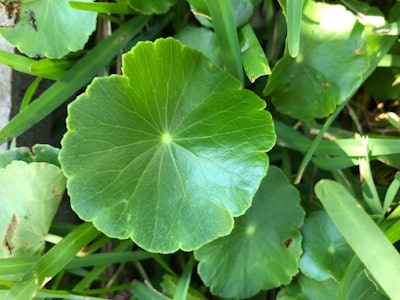
We all know that pesky weeds are simply a part of any lawn and landscape maintenance regimen. Whether you’re proactive and apply preemergent during the right times of year (products that prevent future weeds) or hand pull them, weeds can be a real—and sometimes costly—nuisance.
This article, however, will focus on controlling weeds during the worst time of year for herbicide applications.
Why is summer a bad time for weed control?
Summer is renowned for being one of the worst times of year to apply any weed control products on warm or cool season grass. Weed control products shouldn’t be applied when temperatures exceed 85 degrees F. Combined with the heat, the chemicals found in weed control products will damage the grass or other desired plants it’s applied to.
The ultimate solution is to wait it out until temperatures are consistently below 85 degrees F for several days—usually in the fall—and apply a postemergent herbicide (products that control current weeds) to any weeds that are in your yard. But what if you simply can’t wait that long?
How to control weeds during the summer
Applying any form of weed control product to gardens, landscapes or grass with desired vegetation around is a bad idea during the summer. The summer heat will cause weed control chemicals to burn the surrounding vegetation resulting in a dead or damaged landscape.
With that being said, there are a few other ways to control weeds during the hottest time of the year.
Method 1: Apply a preemergent herbicide in the spring
The first method consists of waiting until next spring and applying a preemergent herbicide to prevent summer weeds from taking hold of your lawn and garden.
This isn’t always the most favored option because of the waiting period, but it’s the most effective method to keep future weeds out.
Method 2: Hand pull them or dig them up
The next method we suggest is hand pulling the weeds or digging them up. Go to your garage or storage shed and grab a pair of gloves and a garden trowel to remove the weeds and a plastic bag to dispose of them.
When hand removing the weeds, be sure to grab from the base of the weed to effectively pull up as many roots from the weed as possible. A small garden trowel will help with digging into the soil to get underneath as much rootage as possible to completely remove the weed.
Be prepared, though—some weeds have long, underground tubers (or runners) that run as much as several feet along the landscape.
If this is the case, you may need a bigger shovel to remove the entire weed. Only pulling the part of the weed that’s above-ground isn’t effective in this case because the long underground tuber will remain in the soil and keep sprouting weeds.
The good news is, once you’ve removed the entire underground runner, that particular weed won’t be making an appearance in your lawn again anytime soon. This is sometimes even more effective than applying a post-emergent herbicide during the more ideal times of the year!
Method 3: Spot treat isolated areas without damaging other plants
The last method we recommend is spot treating isolated areas of weeds in your lawn or garden. In order to do this, you must use a liquid herbicide with a spray tank and nozzle for a more controlled application. Only apply the product to the weed and be careful to not let it touch your lawn or other desired plants.
The nozzle will limit the product from getting on other surrounding, desired vegetation. This same sort of control can’t be used with granular weed control products. Granular weed control products are applied and usually followed by watering the product into the soil. When this is done, the chemicals will spread across the desired vegetation located nearby.
If there are numerous, closely bunched weeds in one area, spot treating may not work. It makes it harder to apply in precise locations and increases the chances of damaging or killing other nearby vegetation.
Be sure to read and follow product labels thoroughly before applying any product to your lawn or garden.
Other Ideas
If you’re someone who loves to stay updated with the latest technology and try new things, you may enjoy these suggestions.
Burn them
Yes, you read that right—burn them! Weed torches are a trending tool that literally burns the weed. However, we advise being very careful with this tool because it can also catch other plants on fire. This tool is best for burning weeds growing through parts of asphalt or concrete. Read product instructions carefully before using.
Use a weed puller tool
A weed puller tool keeps you from having to get on your hands and knees to remove a weed. A stand-up weed puller easily grabs onto weeds and removes them with a metal head. Keep in mind that if you have a weed with a long tuber underneath the soil’s surface, this tool may not be effective.
In conclusion, although summer is the worst time of year to apply weed control products to your lawn and garden, there are still a few workarounds that might get the job done. With any control products or tools, be sure to read and follow product label instructions thoroughly before using.



















